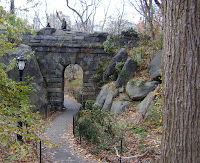“Central Park stands as Olmsted’s sublime achievement, a calm and lovely oasis in the frantic heart of Manhattan Island” (126).
The Book
 Throughout
Genius of Place: The Life of Frederick Law Olmsted, author Justin Martin weaves
the theme of restlessness. Olmsted spent majority of his life jumping from job
to job and interest to interest. It wasn’t until he was forty-five years old
that Olmsted fell into a career as a landscape architect. As you read the book,
you have the sense that Olmsted would have fit in with today’s culture: his
mind wasn’t set on one job for his entire life.
Throughout
Genius of Place: The Life of Frederick Law Olmsted, author Justin Martin weaves
the theme of restlessness. Olmsted spent majority of his life jumping from job
to job and interest to interest. It wasn’t until he was forty-five years old
that Olmsted fell into a career as a landscape architect. As you read the book,
you have the sense that Olmsted would have fit in with today’s culture: his
mind wasn’t set on one job for his entire life.
Genius
of Place is a biography of Olmsted’s entire life, not just the years spent
working on Central Park. He was a sailor, a
farmer, a writer, a newspaper correspondent, an administrator,
an environmentalist, and a landscape architect. Despite all of this, Olmsted will
always be known for the iconic Central Park.
Martin spends several chapters describing the development and construction of
the park, all 778 acres of it. Many of the features Olmsted, and his design
partner Calvert Vaux, planned would take years to develop. In their plan, Olmsted
and Vaux said, “twenty years hence, the town will have enclosed the Central Park. Let us consider, therefore, what will at
that time be satisfactory, for it is then that the design will have to be
really judged” (142). They would spend many years fighting changes in their
plan and trying to stay true to the design.
Olmsted
also designed other prominent American projects: Prospect Park, Brooklyn; the
suburb of Riverside, IL; the Buffalo park system; Washington Park, Chicago;
U.S. Capitol Grounds, DC; Back Bay Fens, Boston; the Stanford University grounds;
the Vanderbilt Biltmore estate; and the 1893 World’s Fair Columbian
Exposition.
The Place

Central Park truly is a magical place. Nestled in the
heart of Manhattan,
it is sometimes easy to forget you are in one of the busiest cities in the world.
A friend and I spent an entire day in Central Park
and we still didn’t see everything. The best way to experience the park is to
simply plan a day (or even two) to wander around. Entry is free, but the
children’s’ zoo, boat rentals, and ice skating have a fee.
There are bridges to cross, boulders to
climb, fields to run through, and lakes to row across. Olmsted’s trees have
grown tall and provide a canopy over the walkways. Twists and turns take you
further away from the noise of the city. Visitors will encounter carriages, but
unless you walk along the outskirts of the park you will not see any cars.
Despite Olmsted’s aversion to statues, there
are several in Central Park that commemorate
well-known figures and others that are long forgotten. My favorite statue is by
the ice skating rink. It depicts a larger than life Hans Christian Anderson
reading a story to the Ugly Duckling.



